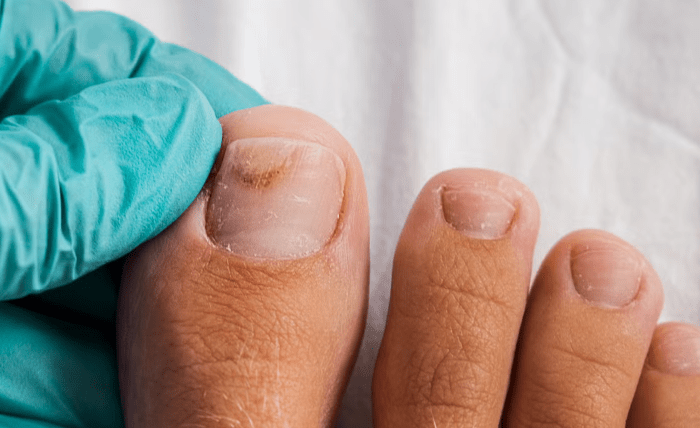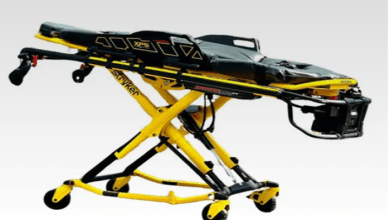
Our feet’s health is often neglected until issues like itchiness or painful bumps appear. This guide aims to help you understand common toe and nail disorders, which is crucial for effective treatment and prevention. It will cover the causes, symptoms, and treatment options for frequent conditions such as athlete’s foot, toenail fungus, and ingrown toenails, among others, to help you maintain healthy feet.
Athlete’s Foot (Tinea Pedis)
Athlete’s foot is a fungal infection that typically begins between the toes. Despite its name, you don’t have to be an athlete to get it. This contagious condition thrives in warm, moist environments like sweaty socks, damp shoes, and public showers.
Symptoms
Common signs of athlete’s foot include:
- An itchy, stinging, or burning rash between the toes or on the soles of the feet.
- Cracked, peeling, or scaly skin.
- Blisters that can be itchy.
- Dry skin on the soles or sides of the feet.
Treatment
Most cases of athlete’s foot can be treated with over-the-counter (OTC) antifungal medications, which come in powders, sprays, and creams. It’s also crucial to keep your feet clean and dry. If the infection is severe or doesn’t improve with OTC treatments, a doctor may prescribe stronger oral or topical antifungal drugs.
Toenail Fungus (Onychomycosis)
Toenail fungus is another common fungal infection that affects the toenails. It often starts as a white or yellow spot under the tip of your nail. As the infection progresses, it can cause the nail to discolor, thicken, and crumble at the edge. The same fungi that cause athlete’s foot can also lead to onychomycosis.
Symptoms
Look out for the following changes in your toenails:
- Thickened nails.
- White to yellow-brown discoloration.
- Brittle, crumbly, or ragged texture.
- A distorted shape.
- A dark color, caused by debris building up under the nail.
- A slightly foul smell.
Treatment
Toenail fungus can be challenging to treat. While OTC creams and ointments are available, they often aren’t very effective. A podiatrist might recommend prescription oral antifungal drugs, medicated nail polish, or medicated nail cream. In persistent cases, nail removal might be necessary to treat the nail bed directly.
Ingrown Toenails
An ingrown toenail occurs when the corner or side of a toenail grows into the soft flesh of the toe. This condition most commonly affects the big toe and can lead to pain, redness, swelling, and sometimes, infection.
Causes
Several factors can contribute to ingrown toenails:
- Cutting toenails too short or not straight across.
- Wearing shoes that are too tight and crowd the toes.
- Toe injuries.
- Having unusually curved toenails.
Treatment
For a minor ingrown toenail, you can try soaking your foot in warm water several times a day and gently lifting the edge of the nail. If the pain is severe or there are signs of infection, such as pus or spreading redness, it’s important to see a doctor. They may lift the nail, partially remove it, or in recurring cases, remove a portion of the nail and underlying tissue.
Bunions (Hallux Valgus)
A bunion is a bony bump that forms at the base of the big toe, on the joint. It develops when the big toe pushes against the next toe, forcing the joint of the big toe to get bigger and stick out. The skin over the bunion might be red and sore.
Causes
Bunions can be caused by wearing tight, narrow shoes, but they can also be a result of an inherited foot shape, foot stress, or medical conditions like arthritis.
Treatment
Conservative treatment options focus on relieving pressure and pain. These include wearing wider shoes, using bunion pads, and taking pain relievers. If the bunion causes persistent pain and interferes with daily activities, surgery may be an option to realign the toe and remove the bump.
Hammertoe
Hammertoe is a deformity that causes a toe to bend or curl downward instead of pointing forward. This condition can affect any toe but is most common in the second, third, and fourth toes. It results from an imbalance in the muscles, tendons, or ligaments that normally hold the toe straight.
Causes
Tight shoes, toe injuries, and an unusual foot structure can all contribute to hammertoe. It’s often found in combination with other foot problems like bunions.
Treatment
Mild cases of hammertoe can be managed with roomier footwear and exercises to stretch and strengthen the toe muscles. If the toe is still flexible, custom orthotics or pads may help. For more rigid and painful hammertoes, surgery might be needed to correct the deformity.
Calluses and Corns
Calluses and corns are thick, hardened layers of skin that develop when your skin tries to protect itself against friction and pressure. Calluses usually develop on the soles of the feet, especially under the heels or balls, while corns are smaller, have a hard center, and tend to appear on non-weight-bearing parts of your feet like the tops and sides of your toes.
Causes
The primary cause is repeated friction or pressure from ill-fitting shoes.
Treatment
Treatment usually involves avoiding the repetitive actions that cause them. Wearing properly fitting shoes, using protective pads, and soaking your feet can help. You can also carefully trim away the excess skin with a pumice stone. For persistent or painful corns and calluses, a podiatrist can safely remove the hardened skin.
Prevention and General Care
Maintaining good foot hygiene is key to preventing many of these common disorders. Follow these simple tips:
- Keep your feet clean and dry, especially between the toes.
- Cut your toenails straight across and avoid cutting them too short.
- Wear properly fitting shoes that provide enough room for your toes.
- Change your socks regularly, particularly if your feet sweat a lot.
- Wear protective footwear like flip-flops in public showers, locker rooms, and around pools.
- Inspect your feet regularly for any changes or signs of problems.
When to Consult a Podiatrist
While many minor foot problems can be managed at home, it’s important to know when to seek professional help. You should see a podiatrist if you experience:
- Persistent pain that doesn’t improve.
- Signs of infection, such as redness, swelling, warmth, or pus.
- Difficulty walking or performing daily activities.
- Changes in the color or shape of your toenails.
- You have diabetes, poor circulation, or a weakened immune system, as foot problems can lead to more serious complications.
Seeking timely advice from foot doctors, such as those in Orem, can ensure you receive the right diagnosis and treatment plan, preventing minor issues from becoming major health concerns.
Conclusion
Your feet are complex structures that deserve regular care and attention. By recognizing the signs of common toe and nail disorders and practicing good foot hygiene, you can keep them healthy and pain-free. If you do encounter a problem, don’t hesitate to seek professional medical advice.




